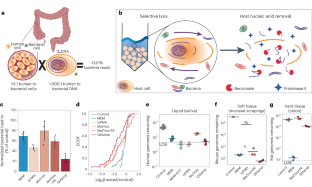2023-10-13 カリフォルニア大学サンディエゴ校(UCSD)
◆この研究はBRAINイニシアティブの一部で、脳の理解と神経細胞タイプの特徴づけに革新的な神経技術を開発することを目指しています。異なる脳細胞タイプの分子レベルの理解は、神経精神疾患の治療法開発に不可欠です。
◆研究者は100万以上の脳細胞を分析し、異なる脳細胞サブタイプを特定し、神経精神疾患との関連を調査しました。また、DNAの配列変異が遺伝子制御に及ぼす影響を予測する機械学習モデルも作成しました。
◆この研究は脳の理解に重要な洞察を提供しますが、脳のマッピング作業はまだ途中です。カリフォルニア大学サンディエゴ校はMultiomic Human Brain Cell Atlasのセンターを設立し、さらに多くの脳を研究して神経精神疾患の生物学を理解し、改善に向けて進展しています。
<関連情報>
- https://today.ucsd.edu/story/human-brain-cell-atlas-offers-unprecedented-look-at-neuropsychiatric-disorders
- https://www.science.org/doi/10.1126/science.adf7044
ヒト脳の単一細胞クロマチンアクセシビリティの比較アトラス A comparative atlas of single-cell chromatin accessibility in the human brain
Yang Eric Li,Sebastian Preissl,Michael Miller,Nicholas D. Johnson,Zihan Wang,Henry Jiao,Chenxu Zhu,Zhaoning Wang,Yang Xie,Olivier Poirion,Colin Kern,Antonio Pinto-Duarte,Wei Tian,Kimberly Siletti,Nora Emerson,Julia Osteen,Jacinta Lucero,Lin Lin,Qian Yang,Quan Zhu,Nathan Zemke,Sarah Espinoza,Anna Marie Yanny,Julie Nyhus,Nick Dee,Tamara Casper,Nadiya Shapovalova,Daniel Hirschstein,Rebecca D. Hodge ,Sten Linnarsson ,Trygve Bakken ,Boaz Levi,C. Dirk Keene ,Jingbo Shang ,Ed Lein ,Allen Wang ,M. Margarita Behrens,Joseph R. Ecker,and Bing Ren
Science Published:13 Oct 2023
DOI:https://doi.org/10.1126/science.adf7044
Structured Abstract
INTRODUCTION
Neuropsychiatric disorders and mental illnesses are the leading cause of disease burden in the United States. Tens of thousands of sequence variants in the human genome have been linked to the etiology of these conditions. However, elucidating the role of the identified risk variants remains a challenge because most of them are outside of protein-coding regions and currently lack functional annotation. These disease risk variants likely exert their influence by perturbing transcriptional regulatory elements, thereby modulating gene expression in cell types pertinent to neuropsychiatric disorders. Recent advancements in single-cell technologies have unveiled a high degree of cellular heterogeneity across the human brain. However, the transcriptional regulatory sequences governing the identity and function of each individual brain cell type remain to be delineated, hindering our ability to interpret the noncoding disease risk variants.
RATIONALE
Conventionally, transcriptional regulatory sequences may be determined by evidence of chromatin accessibility that generally accompanies transcription factor binding and chromatin remodeling. However, prior catalogs of transcriptional regulatory elements lack the information about cell-type–specific activities of each element because of the use of bulk tissue samples. Recent technological strides have empowered us to analyze chromatin accessibility at the single-cell level, enabling the creation of cell-type–specific maps of transcriptional regulatory elements for complex organs such as the human brain.
RESULTS
In this study, we present a comprehensive analysis of chromatin accessibility in the human brain at the single-cell level, encompassing a collection of 1.1 million cells from 42 distinct brain regions in three neurotypical adult subjects. We used this chromatin atlas to define 107 distinct brain cell types and uncovered the state of chromatin accessibility at 544,735 putative transcriptional regulatory elements in these cell types. A substantial number of these regulatory elements also exhibited both sequence conservation and chromatin accessibility in mouse brain cells, underlining their functional importance. Through integrative analysis, we have linked many putative transcriptional regulatory elements to potential target genes. We further leveraged this atlas to predict disease relevant cell types for 19 neuropsychiatric traits and disorders. Finally, we developed machine learning models to predict the regulatory function of disease risk variants. We have made this atlas freely available to the public through an interactive web portal CATLAS (www.catlas.org).
CONCLUSION
The single-cell chromatin atlas of the human brain represents a valuable resource for the neuroscience community. It offers insights into the gene-regulatory programs shaping the diversity of brain cell types and aids in interpreting the functional roles of disease risk variants located outside of protein-coding regions. This atlas, in combination with other molecular and anatomical data, promises to advance our understanding of brain function and neuropathology, ultimately offering avenues for more effective approaches to addressing neuropsychiatric disorders.
Single-cell analysis of chromatin accessibility of the human brain.
Candidate cis-regulatory elements (cCREs) specific to distinct human brain cell types were identified by single-nucleus assay for transposase-accessible chromatin using sequencing (snATAC-seq) and linked to putative target genes through integrative analysis. The usage of cCREs was leveraged to predict brain cell types pertinent to neuropsychiatric traits and disorders and to train machine-learning models to interpret the function of noncoding risk variants. UMAP, Uniform Manifold Approximation and Projection; DL, deep learning; LD, linkage disequilibrium; GWAS, genome wide association study.
Abstract
Recent advances in single-cell transcriptomics have illuminated the diverse neuronal and glial cell types within the human brain. However, the regulatory programs governing cell identity and function remain unclear. Using a single-nucleus assay for transposase-accessible chromatin using sequencing (snATAC-seq), we explored open chromatin landscapes across 1.1 million cells in 42 brain regions from three adults. Integrating this data unveiled 107 distinct cell types and their specific utilization of 544,735 candidate cis-regulatory DNA elements (cCREs) in the human genome. Nearly a third of the cCREs demonstrated conservation and chromatin accessibility in the mouse brain cells. We reveal strong links between specific brain cell types and neuropsychiatric disorders including schizophrenia, bipolar disorder, Alzheimer’s disease (AD), and major depression, and have developed deep learning models to predict the regulatory roles of noncoding risk variants in these disorders.



